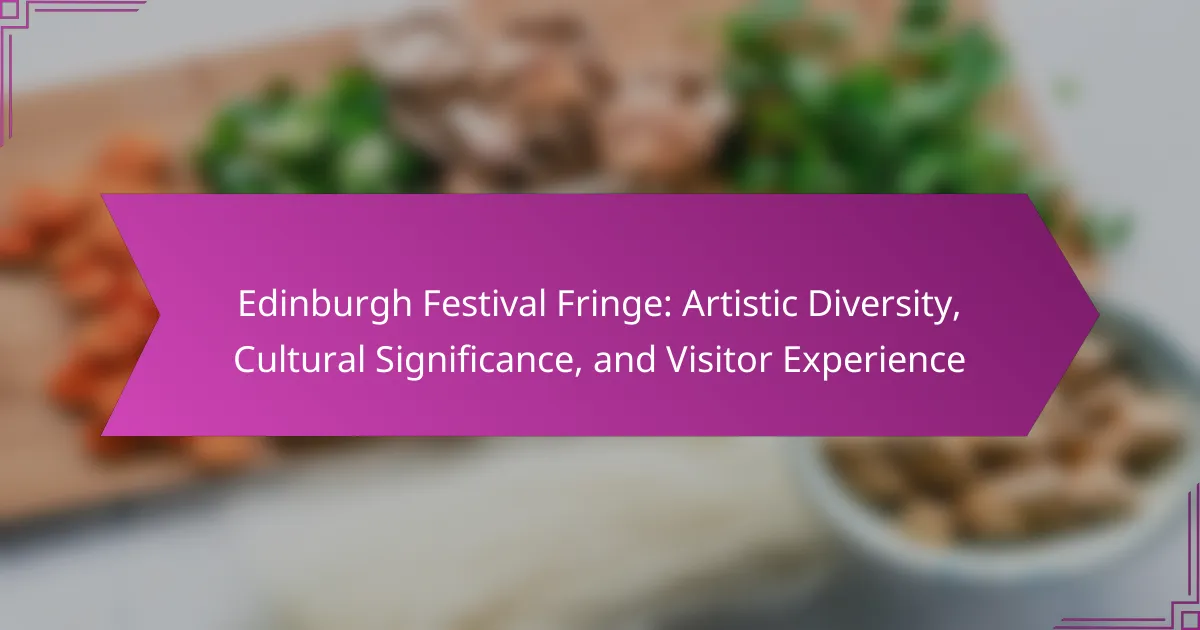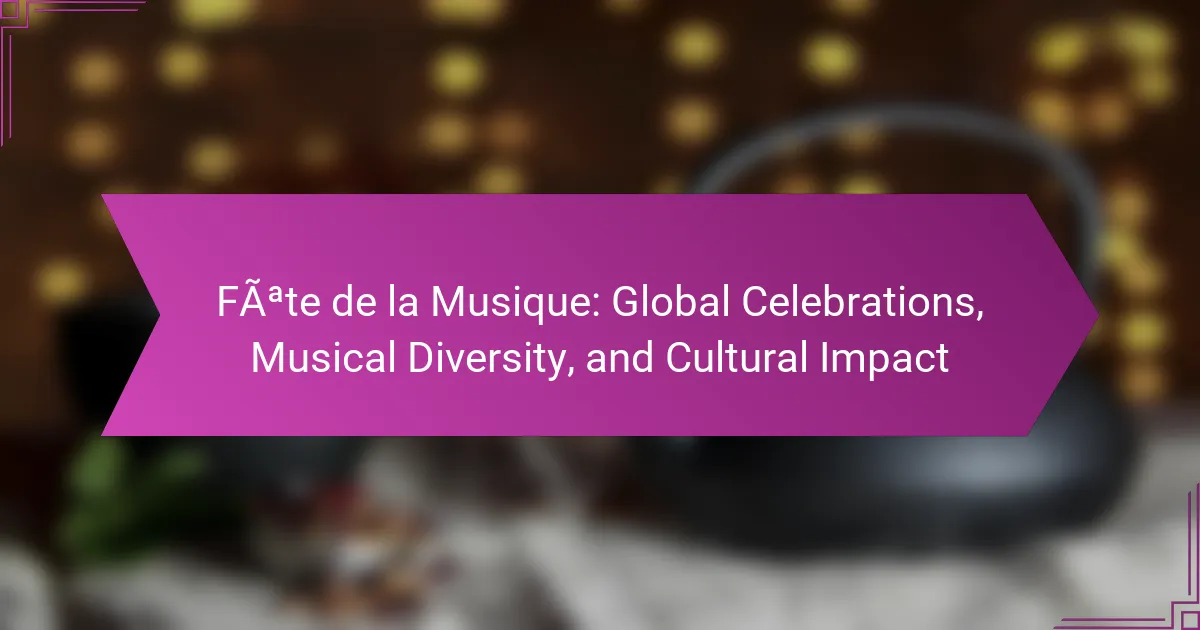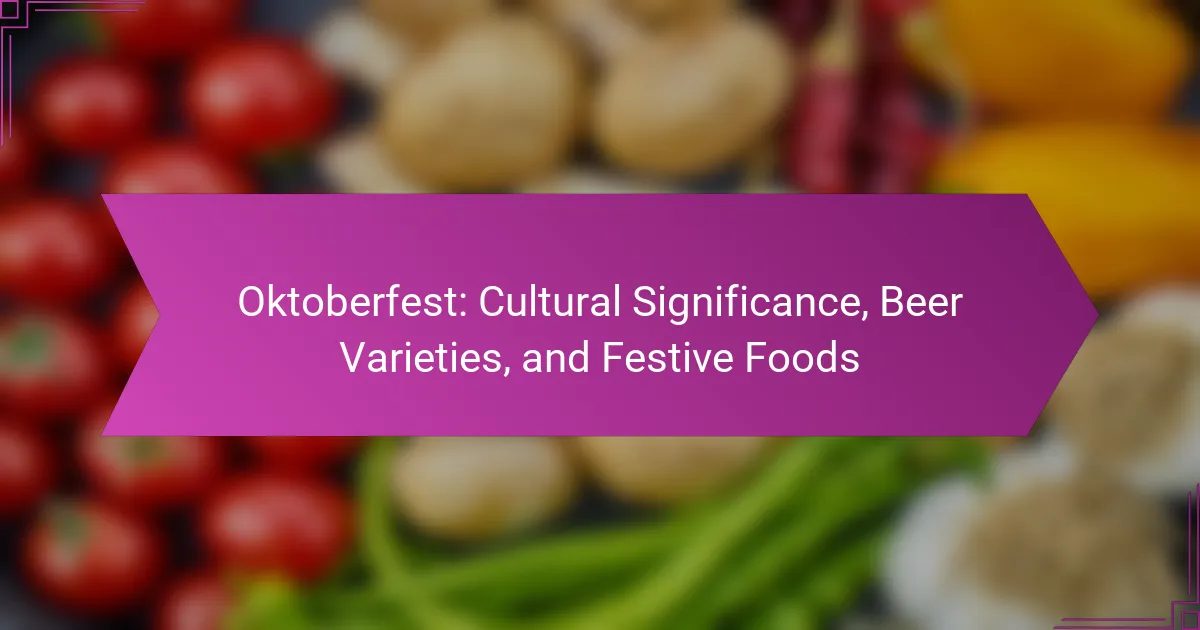The Carnival of Venice offers a unique blend of history, vibrant traditions, and delectable culinary delights. Originating in the 11th century, this festival features elaborate masks and costumes that reflect the city’s rich cultural heritage. Attendees can enjoy traditional foods like fritelle and galani while participating in grand parades and local customs. Understanding the challenges of preserving these traditions adds depth to the Carnival experience.
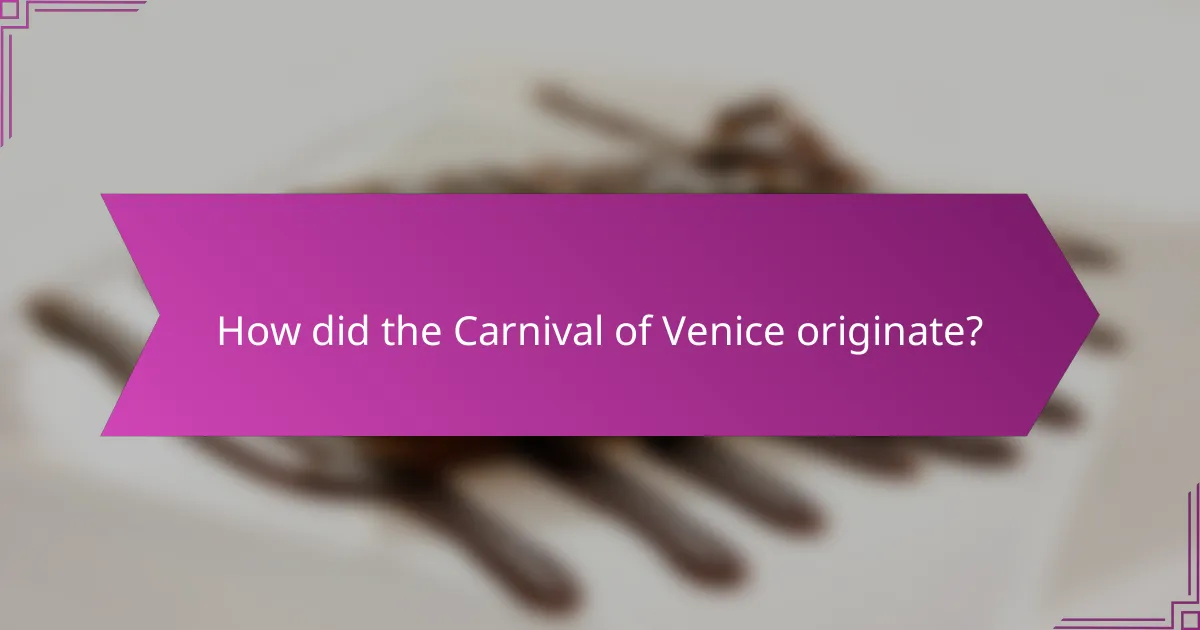
How did the Carnival of Venice originate?
The Carnival of Venice originated in the 11th century as a celebration of the end of winter and the arrival of spring. This vibrant festival features elaborate masks and costumes, reflecting Venice’s rich cultural heritage. Initially, it was a time for socializing and feasting, allowing citizens to indulge in festivities before Lent. Over the centuries, the Carnival evolved, incorporating various traditions and culinary delights that showcase Venetian cuisine. Today, it attracts visitors worldwide, celebrating its historical roots while embracing modern creativity.
What are the key historical milestones of the Carnival?
The key historical milestones of the Carnival of Venice include its origins in the 11th century, the establishment of official celebrations in the 13th century, and the revival in the late 20th century. The carnival began as a time for revelry before Lent, allowing citizens to disguise themselves and enjoy festivities. The 18th century marked its peak, characterized by elaborate masks and costumes. After a decline, the carnival was revitalized in 1979, becoming a major cultural event that attracts millions annually.
How has the Carnival evolved over the centuries?
The Carnival of Venice has transformed significantly over the centuries, evolving from a local celebration to an internationally recognized festival. Initially, it began in the 11th century as a time for revelry before Lent. Over time, the event incorporated elaborate masks and costumes, becoming a symbol of Venetian culture.
In the 18th century, the Carnival reached its peak, attracting nobility and artists, showcasing opulent balls and theatrical performances. The tradition waned in the 19th century but experienced a revival in the late 20th century, emphasizing historical authenticity and culinary delights. Today, the Carnival blends tradition with modernity, featuring parades, street performances, and gourmet food, highlighting the unique attributes of Venetian gastronomy.
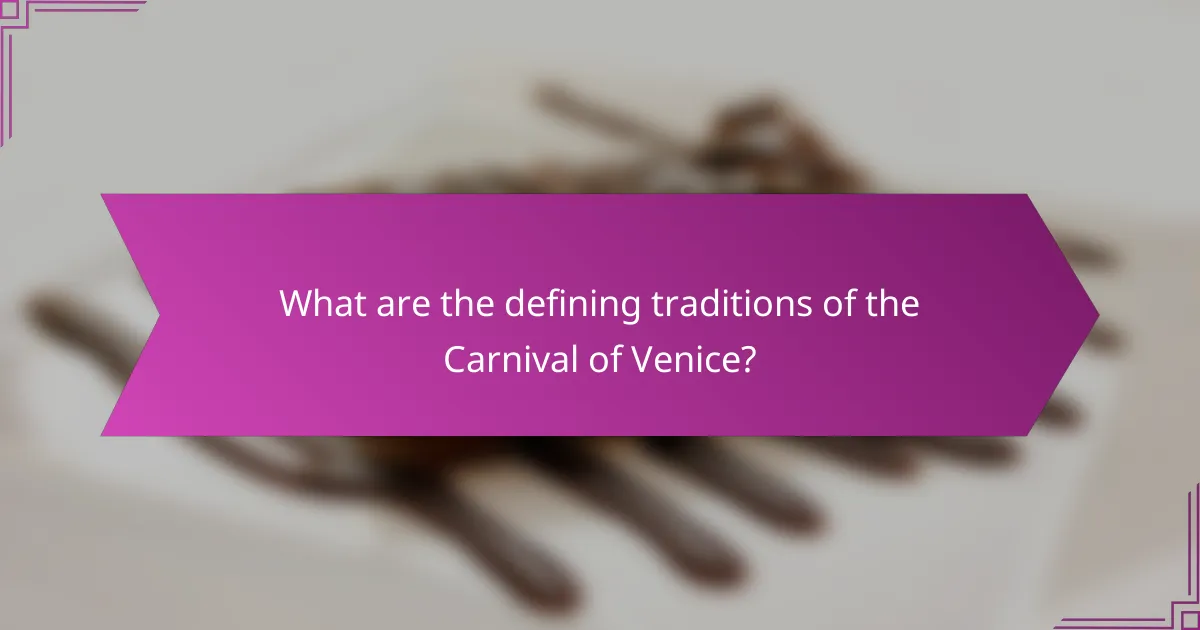
What are the defining traditions of the Carnival of Venice?
The Carnival of Venice is defined by elaborate masks, vibrant costumes, and grand parades. These traditions date back centuries, showcasing the city’s rich history and cultural heritage. Masks symbolize anonymity and social equality, allowing participants to engage freely. The use of traditional foods, such as fritelle and galani, enhances the festive atmosphere. Additionally, events like the Flight of the Angel highlight the carnival’s unique blend of performance and spectacle, drawing visitors from around the world.
Which masks are iconic to the Carnival and what do they symbolize?
The iconic masks of the Carnival of Venice include the Bauta, Columbina, and Moretta, each symbolizing different aspects of life and culture. The Bauta represents anonymity and freedom, allowing wearers to interact freely. Columbina, adorned with intricate designs, symbolizes femininity and charm. Moretta, a black mask, signifies mystery and elegance. These masks reflect the rich history and traditions of the carnival, emphasizing themes of identity and social commentary.
How do costumes reflect the cultural heritage of Venice?
Costumes reflect the cultural heritage of Venice by showcasing its rich history and artistic traditions. The Carnival of Venice features elaborate masks and garments that symbolize social status and historical events. These costumes often incorporate intricate designs, vibrant colors, and traditional materials, highlighting Venice’s craftsmanship. Each costume tells a story, connecting the wearer to the city’s past and its unique identity. The blend of influences from different eras further enriches the cultural narrative represented through these costumes.
What role do parades and performances play in the celebrations?
Parades and performances are central to the Carnival of Venice, showcasing its rich traditions and cultural heritage. These events create a vibrant atmosphere, attracting locals and tourists alike. The elaborate costumes and masks worn during parades highlight the unique attribute of anonymity, allowing participants to express creativity and freedom. Performances often include music, dance, and theatrical acts, enhancing the celebratory spirit and engaging audiences. As a result, these festivities foster community connection and preserve the historical essence of the carnival.
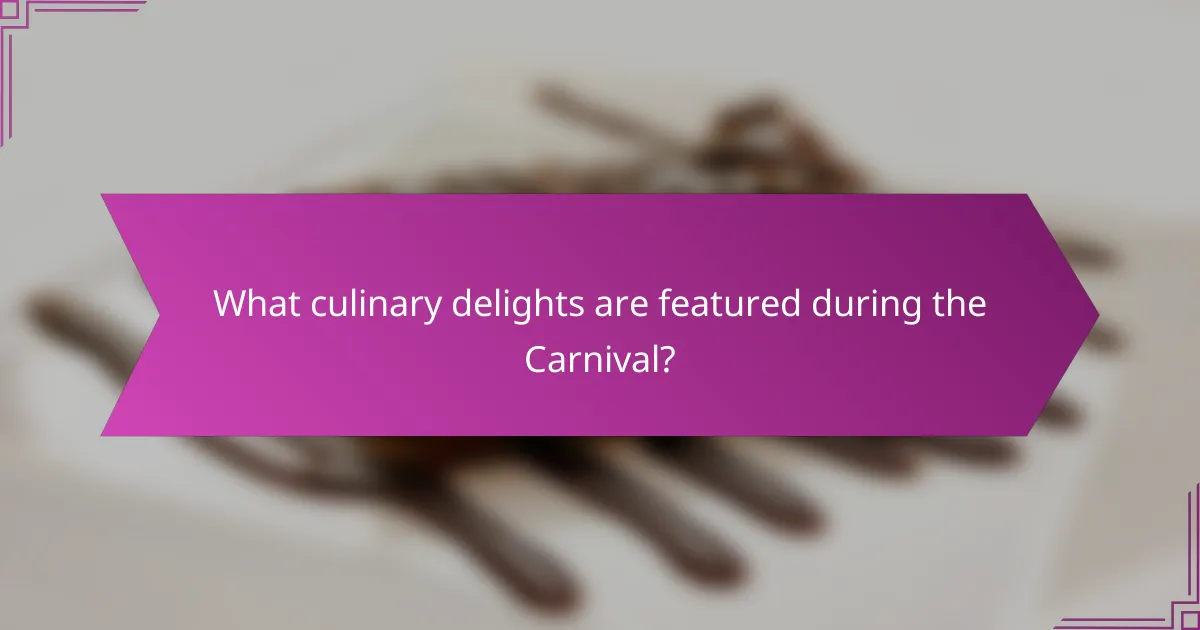
What culinary delights are featured during the Carnival?
The Carnival of Venice features a variety of culinary delights that reflect its rich traditions. Popular treats include fritelle, which are sweet fried dough balls filled with cream or raisins, and galani, crispy pastries dusted with powdered sugar. Additionally, seafood dishes like risotto al nero di seppia, made with cuttlefish ink, showcase local flavors. These delicacies are often enjoyed alongside traditional Venetian wines, enhancing the festive atmosphere.
Which traditional dishes are must-tries during the festivities?
During the Carnival of Venice, must-try traditional dishes include fritelle, galani, and risotto al nero di seppia. Fritelle are sweet fried pastries filled with cream or raisins, while galani are crispy, sugar-dusted dough strips. Risotto al nero di seppia features rice cooked with cuttlefish ink, creating a unique flavor. Each dish reflects the rich culinary heritage of Venice, enhancing the festive experience.
How do local ingredients influence Carnival cuisine?
Local ingredients significantly enhance Carnival cuisine by adding authentic flavors and reflecting regional traditions. The Carnival of Venice showcases a variety of local produce, seafood, and meats, which are integral to its culinary identity. For example, fresh fish from the Adriatic Sea influences dishes like risotto al nero di seppia. Additionally, seasonal vegetables, such as artichokes and radicchio, contribute unique textures and tastes. This emphasis on local sourcing not only supports the community but also preserves culinary heritage, making each dish a celebration of Venetian culture.
What are the popular sweets associated with the Carnival?
Popular sweets associated with the Carnival of Venice include fritelle, galani, and chiacchiere. Fritelle are fried dough balls filled with cream or raisins. Galani are crispy, fried pastries dusted with powdered sugar. Chiacchiere are thin, crunchy strips of dough, often flavored with citrus. These treats reflect the festive spirit and culinary traditions of the Carnival.

How do local customs influence the experience of the Carnival?
Local customs significantly enhance the Carnival experience by adding unique cultural flavors. These traditions shape festivities, influencing costumes, music, and culinary offerings. For instance, Venetian masks symbolize anonymity and social equality, reflecting local history. Culinary delights, such as traditional sweets like fritelle, showcase local ingredients and recipes passed down through generations. The interplay of these customs creates a vibrant atmosphere, making the Carnival a distinctive celebration deeply rooted in Venetian culture.
What unique practices are observed by Venetian families during the Carnival?
Venetian families observe unique practices during the Carnival, including elaborate mask-making and traditional costume design. Families often participate in parades, showcasing their creativity and heritage. Culinary traditions also play a vital role; families prepare special sweets like “frittelle” and “galani” to celebrate. Additionally, storytelling and music are integral, with families gathering to share tales and enjoy local performances. These practices deepen community bonds and keep cultural traditions alive.
How do tourists and locals engage differently with the Carnival?
Tourists and locals engage with the Carnival of Venice differently, reflecting their unique perspectives. Tourists often seek immersive experiences, focusing on the spectacle and vibrant costumes. In contrast, locals participate in traditions, emphasizing family gatherings and community events. Tourists may attend grand parades and performances, while locals enjoy intimate celebrations and culinary traditions. The Carnival’s rich history and cultural significance resonate more deeply with locals, who appreciate its roots and evolving practices.
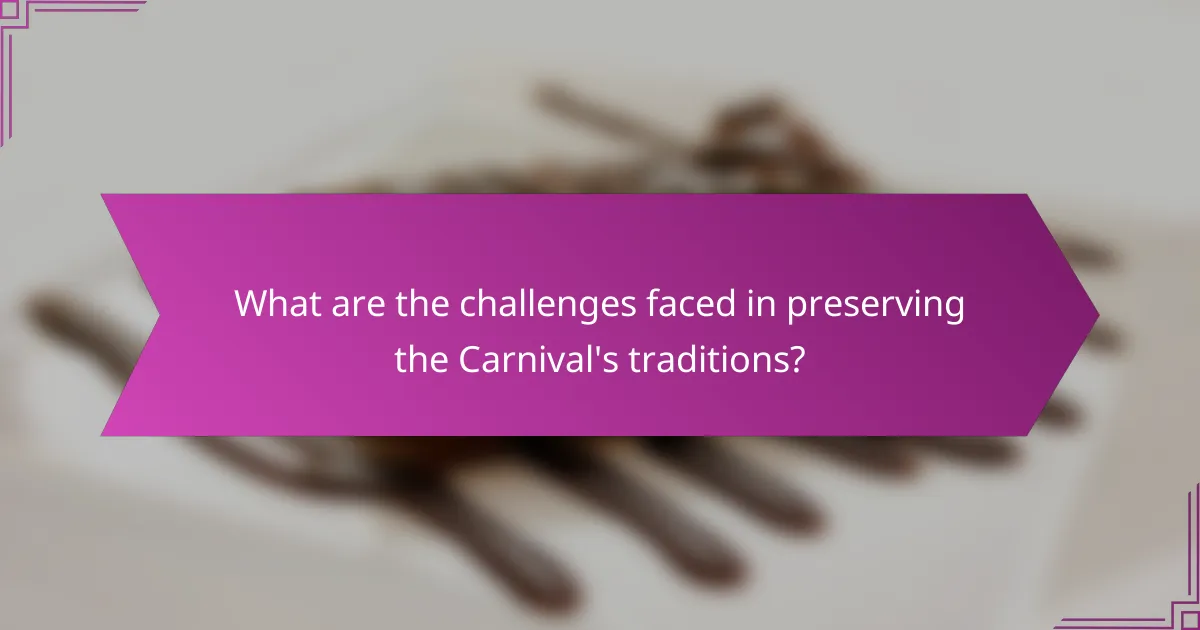
What are the challenges faced in preserving the Carnival’s traditions?
The challenges faced in preserving the Carnival’s traditions include modernization, cultural dilution, and economic pressures. Modern influences often overshadow authentic practices, leading to a loss of traditional elements. Additionally, the commercialization of the event can dilute its cultural significance. Economic pressures may force organizers to prioritize profit over tradition, risking the authenticity of the Carnival experience. These factors threaten the unique identity of the Carnival of Venice and its rich historical heritage.
How is the Carnival adapting to modern influences and tourism?
The Carnival of Venice is adapting to modern influences by incorporating contemporary themes and enhancing tourist experiences. It now features digital marketing strategies to attract global audiences.
Innovations include virtual reality experiences that allow remote participation. Additionally, the event showcases modern art installations alongside traditional masks, blending old and new. Culinary offerings have expanded to include international cuisine, catering to diverse palates.
Sustainability has become a focus, with eco-friendly practices being integrated into event planning. These adaptations ensure the Carnival remains relevant while honoring its rich history and traditions.
What efforts are being made to maintain authenticity?
Efforts to maintain authenticity in the Carnival of Venice include strict regulations on costume design, traditional mask-making techniques, and the preservation of historical performances. Local artisans play a crucial role by using age-old methods to create masks and costumes, ensuring that the event reflects its rich heritage. Additionally, the involvement of cultural organizations helps promote genuine Venetian traditions, fostering community participation and education. These initiatives safeguard the festival’s unique identity and cultural significance.
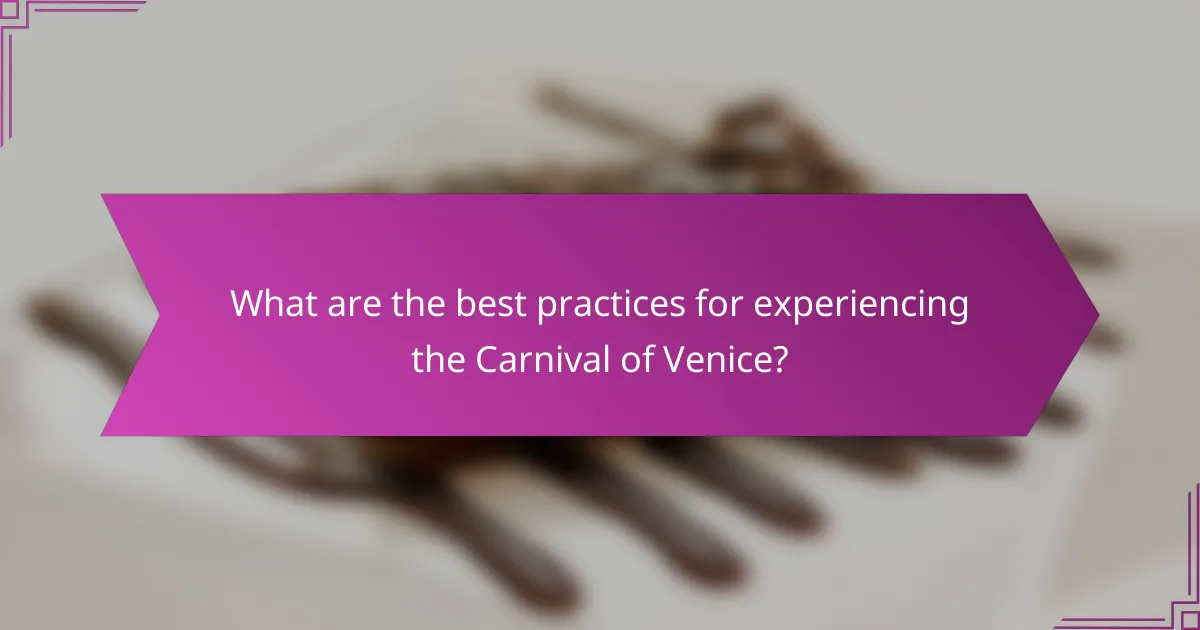
What are the best practices for experiencing the Carnival of Venice?
To experience the Carnival of Venice effectively, prioritize planning, participation in traditional events, and savoring local cuisine. Attend the grand opening ceremony, explore masked balls, and enjoy street performances. Engage with locals to understand the rich history and customs. Taste local specialties like fritelle and galani for an authentic experience.
How can visitors respectfully participate in the celebrations?
Visitors can respectfully participate in the Carnival of Venice by observing local customs and engaging with the community. Dress in traditional costumes to honor the festival’s history. Participate in events and parades while maintaining a respectful demeanor. Engage with locals to learn about the significance of the celebrations. Avoid disruptive behavior to ensure a positive atmosphere for everyone. Embrace the culinary delights by trying local dishes and supporting small vendors.
What tips can enhance the Carnival experience for first-time attendees?
To enhance the Carnival experience for first-time attendees, immerse yourself in the vibrant atmosphere, plan ahead, and engage with local traditions.
1. Research the history and significance of the Carnival to appreciate its cultural depth.
2. Attend the opening ceremony for a grand introduction to the festivities.
3. Dress in a traditional mask or costume to fully embrace the experience.
4. Sample local culinary delights, such as fritelle and galani, to savor authentic flavors.
5. Participate in parades and events to engage with the community and enjoy live performances.
6. Explore lesser-known venues and hidden gems for a unique perspective on the celebration.
